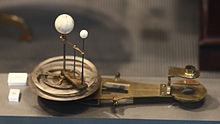Tellurion
Appearance

A tellurion (also spelled tellurian, tellurium, and yet another name is loxocosm), is a clock, typically of French or Swiss origin, surmounted by a mechanism that depicts how day, night and the seasons are caused by the movement of the Earth on its axis and its orbit around the sun. The clock normally also displays the age of the moon, and the four-year (perpetual) calendar.[1]
It is related to the orrery, which illustrates the relative positions and motions of the planets and moons in the solar system in a heliocentric model.
The word tellurion derives from the Latin tellus, meaning Earth.[2]
References
External links
![]() Media related to Tellurion at Wikimedia Commons
Media related to Tellurion at Wikimedia Commons
